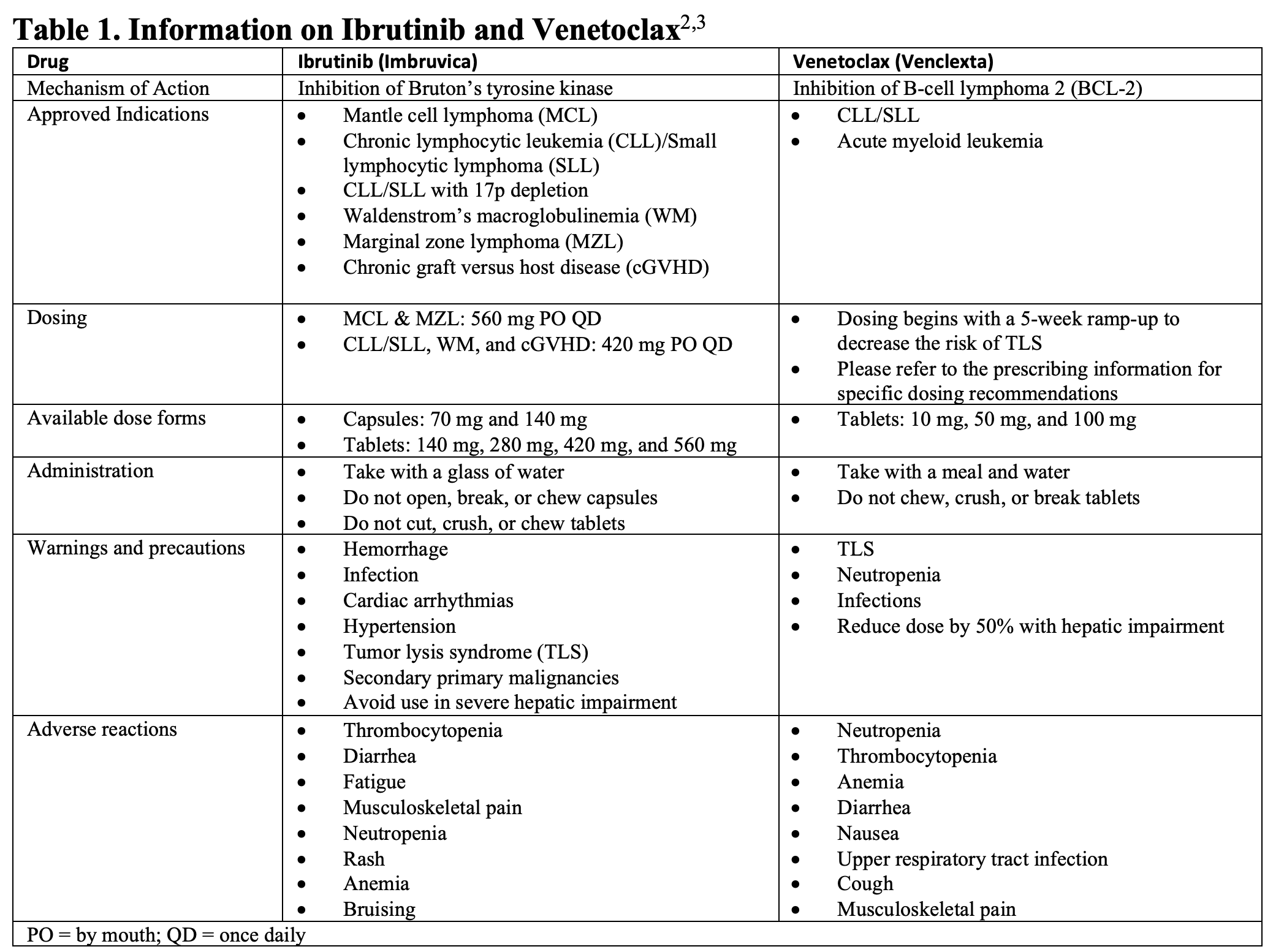Article
Oncology Overview: Treatment of Chronic Lymphocytic Leukemia with Ibrutinib, Venetoclax
Author(s):
Both ibrutinib (Imbruvica) and venetoclax (Venclexta) carry an approved indication for use in chronic lymphocytic leukemia but do not often lead to complete remission, and therapy routinely continues indefinitely or until disease progression.
Introduction
Chronic lymphocytic leukemia (CLL) is a hematologic cancer characterized by proliferation and accumulation of abnormal B-cells in blood, bone marrow, and lymphatic tissue leading to progressive immune dysfunction. CLL is a common cancer with more than 20,000 new cases expected in 2022.1
Traditional treatment involves standard combination chemoimmunotherapy.In recent years, research and a better understanding of CLL’s pathogenesis have led to targeted treatment options.
Several recently published clinical trials have evaluated the combination of ibrutinib (Imbruvica) and venetoclax (Venclexta) in the treatment of CLL with promising results. Both medications carry an approved indication for use in CLL but do not often lead to complete remission, and therapy routinely continues indefinitely or until disease progression.
Table 1 provides each medication's specific drug information.

Clinical Trials
A phase 2 study, published in the New England Journal of Medicine in May 2019, evaluated the combination of ibrutinib and venetoclax in high-risk and older patients with previously untreated CLL. The treatment involved lead-in monotherapy with ibrutinib, followed by combination therapy with ibrutinib and venetoclax (using the traditional ramp-up dosing to minimize tumor lysis syndrome). Complete remission was achieved in 88% of patients and 61% of patients had remission with undetectable minimal residual disease (uMRD).4
The phase 2 CLARITY clinical trial studied the ibrutinib and venetoclax combination in patients with relapsed or refractory CLL. Initial treatment consisted of monotherapy with ibrutinib followed by combination therapy with ibrutinib and venetoclax (using the traditional ramp-up dosing).
The primary endpoint was eradication of MRD to fewer than 1 cell in 10,000 leukocytes. After 12 months of therapy, 53% of patients met this endpoint in peripheral blood and 36% met the endpoint in bone marrow. Additional results included an 89% patient response rate and a 51% patient complete remission rate.5
The phase 2 CAPTIVATE clinical trial evaluated therapy with ibrutinib and venetoclax in patients between 18 and 70 years of age with previously untreated CLL. The study consisted of a cohort evaluating minimal residual disease (MRD) and a second evaluating a fixed-dose (FD) regimen.
In the MRD cohort, eligible patients received treatment in 2 phases. During the first phase, patients received monotherapy with ibrutinib, followed by combination therapy with ibrutinib and venetoclax (using the traditional ramp-up dosing).
Based on MRD status and tumor response assessment at the end of the first phase, patients progressed into 2 different additional treatment arms. After 12 cycles of combination therapy, 75% of patients achieved uMRD in blood and 68% in bone marrow.6
The FD cohort of the CAPTIVATE study evaluated patient response to fixed-duration combination treatment with ibrutinib and venetoclax. Dosing involved lead-in monotherapy with ibrutinib, followed by combination therapy with ibrutinib and venetoclax (using the traditional ramp-up dosing). The study’s primary endpoint, progression-free survival (PFS), was met in 55% of study participants.7
The phase 3 GLOW clinical trial evaluated fixed-duration therapy of ibrutinib and venetoclax compared to chlorambucil and obinutuzumab in patients 65 years of age or older or 18-64 years of age with comorbidities and previously untreated CLL. The primary endpoint of PFS was higher in patients treated with ibrutinib/venetoclax compared to treatment with chlorambucil/obinutuzumab.
About the Author
Jennifer Salvon is a licensed pharmacist in Massachusetts and Connecticut and a student in UConn's Medical Writing Certificate Program.
References
- American Cancer Society: Cancer Facts and Figures 2022. American Cancer Society, 2022. Accessed July 1, 2022. https://www.cancer.org/content/dam/cancer-org/research/cancer-facts-and-statistics/annual-cancer-facts-and-figures/2022/2022-cancer-facts-and-figures.pdf
- Imbruvica prescribing information. May 2022. Accessed June 29, 2022. https://www.imbruvica.com/files/prescribing-information.pdf
- Venclexta prescribing information. June 2022. Accessed June 29, 2022. https://www.rxabbvie.com/pdf/venclexta.pdf
- Jain N, Keating M, Thompson P, et al. Ibrutinib and Venetoclax for First-Line Treatment of CLL. N Engl J Med. 2019;380(22):2095-2103. doi:10.1056/NEJMoa1900574
- Hillmen P, Rawstron AC, Brock K, et al. Ibrutinib Plus Venetoclax in Relapsed/Refractory Chronic Lymphocytic Leukemia: The CLARITY Study [published correction appears in J Clin Oncol. 2020 May 10;38(14):1644]. J Clin Oncol. 2019;37(30):2722-2729.
- Wierda WG, Allan JN, Siddiqi T, et al. Ibrutinib Plus Venetoclax for First-Line Treatment of Chronic Lymphocytic Leukemia: Primary Analysis Results From the Minimal Residual Disease Cohort of the Randomized Phase II CAPTIVATE Study. J Clin Oncol. 2021;39(34):3853-3865.
- Tam CS, Allan JN, Siddiqi T, et al. Fixed-duration ibrutinib plus venetoclax for first-line treatment of CLL: primary analysis of the CAPTIVATE FD cohort. Blood. 2022;139(22):3278-3289. doi:10.1182/blood.2021014488
- Kater ap, Owen C, Moreno C, et al. Fixed-Duration Ibrutinib-Venetoclax in patients with Chronic Lymphocytic Leukemia and Comorbiditites. NEJM Evidence. 2022;1(7):1-13. doi;10.1056/EVIDoa2200006
Newsletter
Stay informed on drug updates, treatment guidelines, and pharmacy practice trends—subscribe to Pharmacy Times for weekly clinical insights.






